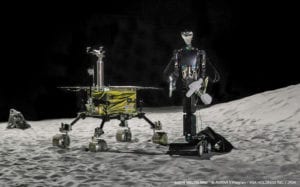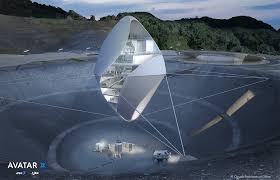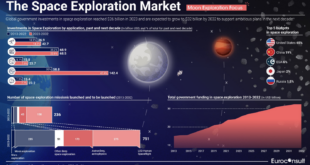By John B. Sheldon
The Power of Metaphor
Since the launch of the first satellite, Sputnik I, on 4 October 1957 our presence in space has been described, defined, and politically and technologically driven by metaphors.
The U.S.-Soviet space programmes in the Cold War weren’t just in competition, they were in a ‘Space Race’; in the 1960s historians used the great railroad-building boom that connected America’s East and West coasts in the 19th Century as a metaphor for humanity’s economic future in space; more recently, the space ambitions of Elon Musk, Sir Richard Branson, and Jeff Bezos have been compared to the pyramid-building of the ancient Egyptian Pharaohs, and on top of that, these three billionaires are now engaged in a ‘New Space Race’.
Metaphors big and small influence how we perceive the world and the choices we make in navigating life’s complexities. Science and technology are no different, as humanity in the modern era has already lived through the metaphorical mechanistic, thermodynamic, and cybernetic ages with their respective iconic clock, engine, and computer technologies.
British scholar Antoine Bousquet argues that we are currently living in the chaoplexic scientific age, with the network as its lodestar technology. A growing number of scientists and technologists speculate that we might be on the cusp of the quantum scientific age, with its principles of entanglement, superposition, and the multiverse providing the metaphorical framework for how humanity will not only perceive science and technology, but also culture, politics, war, the environment, and medicine.
Humanity’s future in space, and its sense of how that presence in space will be fulfilled, will also be influenced by this metaphor derived from quantum mechanics, but more on this later.
A Quantum Age?
Metaphors are by nature inexact and prone to misuse, and the so-called Quantum Age metaphor is no different.
The actual science of quantum mechanics tends to confound even those who study and research it as a profession, and while there has been great progress over the past several years in quantum cryptography, computers, communications, and even sensing and navigation, none of these technologies have yet to reach maturity and mainstream use.
Undoubtedly many quantum physicists and engineers would bristle at the suggestion that quantum mechanics could be used as a universal sensemaking metaphor.
The quantum metaphor is gaining currency, however. Armenian president Armen Sarkissian (who prior to his political career was a noted theoretical physicist) is convinced that contemporary global politics and geopolitics exhibits quantum-like behaviour thanks to the convergence of digital and network technologies.
For example, the recent unrest in Hong Kong and in Santiago, Chile, have exhibited quantum-like behaviour as protestors in each city learned from each other in real-time new tactics that could evade or even take on the police forces attempting to quell the unrest. This learning has been facilitated by instantaneous mass communications, and a change of protestor tactics in Hong Kong would, within hours, change the character of the protests in Santiago, and vice versa.
Global and real-time connectivity means that an event in one part of the world usually changes the political state somewhere else within a short period of time – similar to the concept of entanglement in quantum mechanics.
Our Space Future in the Quantum Age
If it’s likely that humanity is on the cusp of a metaphorical Quantum Age, how will it happen and what will it mean for our future in space?
First, even if quantum technologies do mature, human spaceflight in deep space along with habitation on the Moon and Mars will still be dangerous and prohibitively expensive. This doesn’t mean that there won’t be a role for human space exploration and commerce in the future, but it is unlikely to involve large numbers of individuals.

In other words, our current thinking about what the future of humans living and working in space looks like is stuck in an analogue mindset. Similarly, visions of an exclusively robotic presence in space are stuck in a digital mindset.
A quantum mindset for our presence in space not only brings humans and robots together, but also broadens the number of people who will participate in the space commerce and exploration endeavor.
Second, the convergence of various technological trends – and not just quantum technology – will matter. The Quantum Age will depend on advanced network capabilities such as 5G, 6G, 7G – and even beyond – as well as space-based laser communications that provide the low-latency connectivity required for Earth-based control of space operations in deep space and on the Moon, Mars, and further out in the Solar System.
Third, space exploration, resource extraction, and other space activities will be carried out by avatar-robots that are controlled by humans on Earth or in orbit around the Moon or Mars. These operations will take place thanks to advances in virtual and augmented reality technologies that will use haptic-neurotechnology instead of the clunky VR visors we have today.
Advances in haptics will also be necessary, as well as in artificial intelligence that can keep avatar-robots operating under demanding circumstances by taking up some of the slack caused by the inevitable latency in communications over the vast distances involved.
Space activities in the future will be about human-machine partnerships supported and supplemented by artificial intelligence, not autonomous robotic missions or vast numbers of human beings.
Fourth, the same advances that enable virtual reality and avatar-robots will create planetary-scale ‘mirrorworlds‘ that will provide virtual representations of the Moon, Mars, and eventually all other celestial bodies throughout the Solar System.
These planetary mirrorworlds, created by highly detailed and exquisite three-dimensional mapping of a planet’s (or moon’s) surface and subsurface by satellites and surface-based sensors, will be the primary means by which humans on Earth will explore, work, and play in space.
In our present timeline, the Earth-bound mirrorworld is already being built — thanks to virtual reality and the burgeoning internet of things. In the Quantum Age, however, there will be an internet of interplanetary things and haptic-neurotechnological virtual and augmented realities.
In the Quantum Age low-latency inter-planetary connectivity and virtual mirrorworlds, coupled with avatar-robotics featuring sensitive haptics will allow Earth-bound scientists in California to explore in detail a cave complex on Mars, while miners in Mongolia harvest rare metals from an asteroid, and engineers in Germany drill for water in the frigid southern polar region of the Moon.
Metaphors We Might Live By? Entanglement, Superposition, and the Multiverse

When we think about the underlying concepts of quantum mechanics, these converging technological trends create quantum-like metaphorical phenomenon such as entanglement, superposition, and the multiverse.
Humans with haptic-neurotechnological wearables or implants virtually working off-planet through avatar-robots destroys the digital-physical divide that is already blurring today. The intimate connectivity this produces between human and machine over vast distances evokes the concept of entanglement where a change of state in one particle influences the state of another — even though they are separately located.
That same intimate human-machine connectivity also allows us to imagine an individual and their avatar-robot to be in superposition, where the human-machine entity has two different states and the entity exists in both human and machine realms simultaneously. This human-machine superposition has profound implications for our evolutionary future as it implies a transhumanist existence where biology and technology merge into one.
Planetary and Earth-bound mirrorworlds – vast and numerous virtual representations of physical environments – will exist alongside other virtual worlds created for political-geopolitical, cultural, religious, commercial, and lifestyle purposes. These mirrorworlds will in effect become the digital equivalent of the contested theory in quantum mechanics that suggests there are many universes existing in parallel to each other.
In the Quantum Age there will be as many mirror- and-virtual worlds as there are political, cultural, religious, and commercial perspectives, complicating the politics of humanity’s presence in space as well as on Earth.
Far from being a future of Zen-like aesthetics and harmonious coexistence, the Quantum Age will be exciting but also messy, uncertain, and hard to fathom.
This speculative future in space raises many questions rather than answers, not least of which, are we ready for – and do we want – a Quantum Age?

Dr. John B. Sheldon is the co-publisher of SpaceWatch.Global, and is the President, Chairman, and Chief Strategy Officer of ThorGroup GmbH. The views expressed here are his alone.
 SpaceWatch.Global An independent perspective on space
SpaceWatch.Global An independent perspective on space





